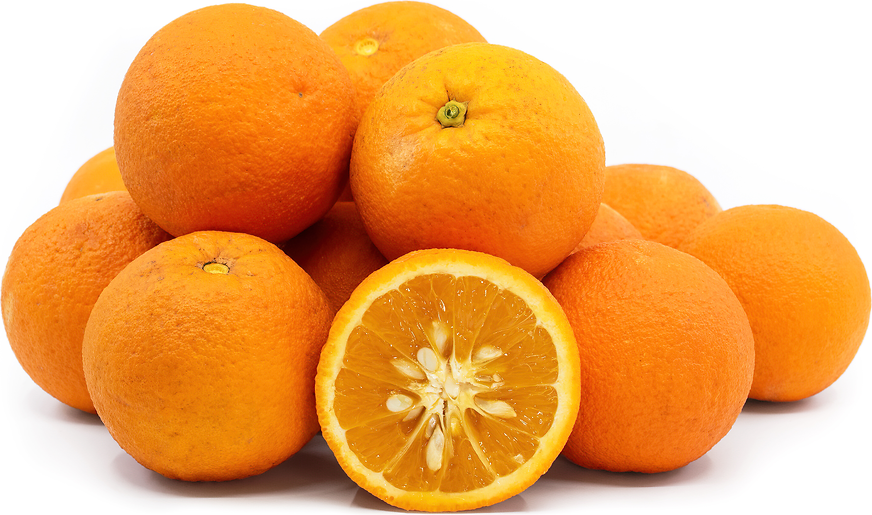


Sekeri Oranges
Estimated Inventory, lb : 0
Description/Taste
Sekeri oranges are a small to medium-sized varietal, averaging 6 to 8 centimeters in diameter, and have a round, oblate, to slightly elongated shape, depending on growing conditions. The skin is semi-thin, taut, and leathery, covered in sunken oil glands, giving the surface a pitted, bumpy, textured feel. Prominent creases occur around the stem end, and the rind ripens from green to shades of yellow-orange, orange, and red-orange. Sekeri oranges are challenging to peel as the rind breaks off in small chunks. Underneath the surface, the flesh is divided into 9 to 12 slender segments by thin membranes. The orange flesh is tender, aqueous, and soft with a succulent consistency. The flesh also envelops cream-colored seeds that should be discarded during consumption. Sekeri oranges release an aromatic, bright, and fruity scent. The variety is edible raw once ripe and is known for its high sugar content, creating a mild, sweet, and sugary taste. Some consumers note that the juice leaves a lingering sweetness on the palate with a hint of an orange cream aftertaste.
Seasons/Availability
Sekeri oranges are available from winter through spring.
Current Facts
Sekeri oranges, botanically classified as Citrus sinensis, are a sweet variety belonging to the Rutaceae or citrus family. The aromatic cultivar is thought to have origins in Turkey and is an early-season type of sweet orange. Sekeri oranges are known by many names throughout the Mediterranean, including Sikeri, Sukari, Dolce, Crescent, Akcay Sekeri Crescent, Akcay Sugar, and Crescent Sweet oranges. Throughout history, Sekeri oranges have remained a traditional sweet orange in Turkey and initially became popular for their contrasting flavors to bitter oranges, the first types of oranges grown in the country. With the introduction of sweet varieties like Sekeri, growers shifted to cultivating sweet oranges and later expanded cultivation across the Eastern Mediterranean as a fresh-eating cultivar. The variety is not well known outside of its growing regions and is considered a smaller-scale commercial fruit. Sekeri oranges are primarily reserved for juicing and are valued for their refreshing, mild, and sweet taste.
Nutritional Value
Sekeri oranges are a source of fiber to regulate and cleanse the digestive tract and antioxidants to reduce inflammation while protecting the body’s overall health. Oranges also provide calcium and phosphorus to support bones and teeth, potassium to balance fluid levels within the body, and magnesium to control nerve functions. Other minerals include iron, which develops the protein hemoglobin for oxygen transport through the bloodstream, zinc, and manganese. Sekeri oranges also contain vitamins A, C, and E to maintain healthy organs, strengthen the immune system, and guard the cells against the damage caused by free radicals.
Applications
Sekeri oranges have a mild, sweet, and fruity flavor suited for fresh and cooked preparations. The variety is famous for pressing into juice and is incorporated into a wide array of chilled beverages like smoothies, cocktails, fruit punches, and shakes. Sekeri oranges are also sliced and consumed as a stand-alone snack or served on fruit platters. Try dipping slices into dark chocolate. The slices are then sprinkled with crushed nuts and allowed to harden, becoming a visually pleasing appetizer or dessert. Oranges are also segmented into salads or used as a fresh topping over sweet and savory dishes. In addition to raw preparations, Sekeri oranges are simmered into jams, jellies, marmalades, and syrups. They are also used as flavoring in cakes, rolls, bars, and muffins, or the juice is mixed into puddings and custards. In Turkey, Sekeri oranges are incorporated into Turkish delight, a soft, chewy confection, or mixed into the dough for sugar cookies. They are also infused into dressings or sauces and poured over roast meats and vegetables. Sekeri oranges pair well with spices such as cinnamon, clove, allspice, and ginger, other fruits including strawberries, blueberries, grapefruit, and apricots, and meats such as pork, beef, veal, and poultry. Whole, unopened Sekeri oranges will keep for a few days at room temperature or for a week or two when stored in the fridge.
Ethnic/Cultural Info
The name Sekeri translates from Turkish to mean “sugar.” This descriptor was given to the variety for its high sugar content and famous sweet taste. Oranges are also generally known as “portakal” in Turkish, which is derived from the word “Portekiz,” meaning “Portugal.” Legend has it that this curious name was acquired through sweet oranges arriving in areas of Turkey through trade routes run by the Portuguese. Portuguese sailors and traders introduced Sweet oranges throughout the Mediterranean during the 16th century, and communities began naming the fruits after the Portuguese in different languages and dialects. As oranges were spread, the name was also shared between cultures, intertwining the Portuguese with sweet oranges. Portakal is still used in Turkish for oranges in the modern day and has become a traditional name with historical roots.
Geography/History
Sekeri oranges are believed to be native to Turkey. Much of the variety’s origins are unknown, but sweet oranges of the Citrus sinensis species were introduced to Turkey sometime in the late 15th century from Asia. Sweet oranges were initially carried along trade routes established by the Genoese, a people group from northwestern Italy. Sweet oranges were also spread across the Mediterranean through Portuguese trade routes in the 16th century. Sometime during the second part of the 15th century, sweet oranges were planted in Greece. Today, Sekeri oranges are grown in the Eastern Mediterranean, including Turkey and the island of Crete. They are also found in Egypt and grown as a specialty citrus worldwide in home gardens. The Sekeri oranges featured in the photograph above were sourced through fresh markets in Heraklion, the capital city of the island of Crete.




